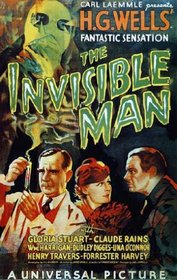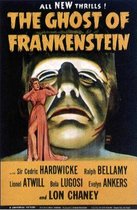Our editor-in-chief Nate Yapp is proud to have contributed to the new book Hidden Horror: A Celebration of 101 Underrated and Overlooked Fright Flicks, edited by Aaron Christensen. Another contributors include Anthony Timpone, B.J. Colangelo, Dave Alexander, Classic-Horror.com's own Robert C. Ring and John W. Bowen. Pick up a copy today from Amazon.com!
The Invisible Man (1933)
Opening with an original music piece that perfectly mixes the moods of horror and fantasy, The Invisible Man quickly asserts the difference between it and all previous Universal horror films (a great deal of which utilized Tchaikovsky's "Swan Lake"). This is not another monster melodrama, but a wacky knockabout black comedy (with the requisite moments of blood and thunder), the type that only director James Whale could produce.
A mysterious figure, swathed in bandages, has checked into the Lion's Head Inn in Iping during a blustering winter storm. Who is this man? Why is he wrapped in gauze? Well, it wouldn't be much of an Invisible Man movie if the answers didn't have something to do with human transparency. The stranger is Dr. Jack Griffin and he has three problems: 1) he's invisible, 2) he can't reverse the process, and 3) he's become a bit, ah, megalomaniac.
The film is at its very best in its opening sequence. Most of the action is limited to the Lion's Head, the sort of English country tavern that's just loaded with the wacky bit characters that Whale loved (and who can be seen as predecessors to Preston Sturges's wide array of "mugs" in such classic films as Sullivan's Travels). The wackiest of these is Jenny Hall (Una O'Connor). O'Connor's shrill voice and even shriller shriek are landmarks of the early horror film and both are put to excellent use here.
It takes seventeen minutes for the film to work towards its revelation of Griffin's secret in full, and it's a delightful build-up. Even now, some seventy years after the scene became well-known and wholly expected, it's still a thrill, mainly due to the cackling playfulness of Rains' vocals.
Indeed, for a role that involves almost no visibility, Rains brilliantly dominates the film, putting his golden sinister voice to excellent use. His ostentatious delivery of even the blackest of jokes (especially for those jokes, in fact) turns what could have been just a special effects film into a true gem.
But oh, what special effects they are! Say what you life about computer imagery, it will never be as impressive as the meticulous physical artistry on display here from cinema wizard John P. Fulton. Using early versions of blue screen technology (utilizing black velvet) and certain wire tricks, Fulton nearly consistently delivers the illusion that there's a presence without visible substance. Although a few shots are misjudged (a supposedly naked Griffin leaves shoeprints in the snow, and apparently does not inhale when he smokes), it's small potatoes compared to the rest of the technical delights.
If the film suffers from anything, it's the inclusion of Dr. Cranley (Henry Travers, It's a Wonderful Life) and his daughter Flora (Gloria Stuart, The Old Dark House). Neither character is in H. G. Wells's novel, and they don't feel like a natural part of the narrative, too often adding a maudlin note to an otherwise madcap film. I can see where screenwriter R. C. Sherriff was going with it - including Dr. Kemp (William Harrigan), there's a definite parallel to the friendly faces opposing Henry Frankenstein in Whale's masterpiece Frankenstein (Cranley, Flora, and Kemp equal Waldman, Elizabeth, and Victor). It's not a bad role model in terms of structure (and in many ways, Sherriff improves on the relationship dynamics), but it does force the inclusion of an extraneous romantic subplot that goes nowhere.
Whatever Sherriff's inspirations, the tone of the film is all Whale. In The Old Dark House, we glimpsed our first of Whale's darkest humors, and they hurtle towards full power here in The Invisible Man (eventually, they hit 100% in the great but dramatically unbalanced Bride of Frankenstein). Anyone unable to laugh when they see a pair of empty trousers gaily skipping down the road (singing "Here we go gathering nuts in May..") should have their funny bone examined. This is all Whale's personal comedy club of horror, and he wants the audience to gasp in shock even as they struggle to breathe between guffaws.
The Universal DVD is sadly out-of-print; If you can find a copy, do so. The commentary track by film historian Rudy Behlmer is chock-full of good info (and provided at least some of the interesting trivia in this review), although he often sounds as though he's narrating an episode of "Biography" rather than laying down a scene-specific track. The film has been lovingly restored (though not as well as Frankenstein) and features a crisp, clean audio track. Find it, watch it, love it.
Trivia:
The film saw eleven different drafts, including attempts by Garrett Fort, John L. Balderston, John Huston, and Preston Sturges. No single draft had much in common with any other draft, and most had nothing to do with H. G. Wells at all! Sherriff's final, produced screenplay was the closest of all of them to the original novel.
Many of the rejected drafts were based on Philip Wylie's "The Murderer Invisible," another Universal property.
Boris Karloff was the studio's original choice for the Invisible One. However Whale always had his, ah, ear on Rains.









Three
Three words:
BEST
MOVIE
EVER!!!!!!!!!